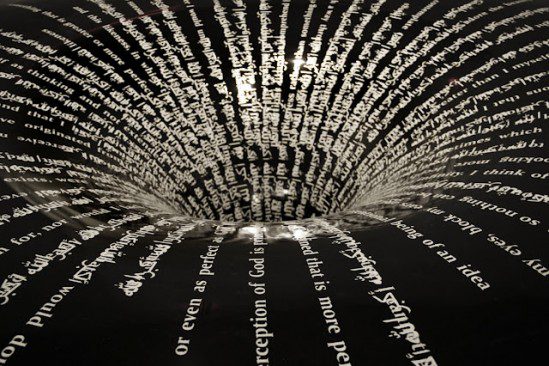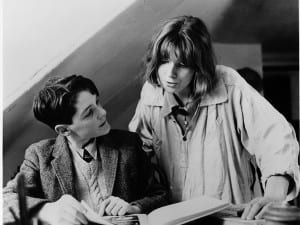Text by Carol Huston
Born into a Muslim family in Birmingham in 1978, London-based artist Idris Khan decided to stop practising Islam when he was fourteen years old. Despite this, he is now reknowned for producing Islamic-themed works which garner public acclaim. In a recent interview, Khan likened the practice of reading the pages of the Qur’an to his artistic process, which he described as a continual return to the same place. For Khan, this place appears to be found in the methodic repetition of found texts, written or photographic. For his current exhibition at the Whitworth Art Gallery in Manchester, Khan’s recent works overlap written texts, obscuring the traditional understanding of how we read and communicate.
Khan’s work challenges notions of original authorship, recalling Roland Barthes’s seminal 1967 essay The Death of the Author. No stranger to the writing of Barthes, Khan used the pages of Camera Lucida (1980) as subject matter in 2006. Like the masters of appropriation who preceded Khan, such as Richard Hamilton, Eduardo Paolozzi and Andy Warhol, Khan reinterprets found texts and reworks them to suit the interests of his current practice. In line with Barthes’ essay on dubious authorship, Khan acknowledges that he is not the sole author of his works by allowing room for multiple readings interpretations according to the viewer’s perspective. For the seven drawings from the series of twenty-one prints, 21 Stones (2011), Khan combines verses from the Qur’an with melancholic personal notes; “My mother died on the 23rd January 2010.” “God is great.” “We lost our baby” “Why did this happen?” For the prints, the artist combines Arabic, the language of the Qur’an, with English phrases, nodding to his Muslim heritage. Departing from his artistic roots in the manipulation of photography, Khan hand-printed the drawings using bespoke stamps. The repetition of stamps in a block-printing fashion creates a rythmic, circular pattern on each print, akin to concrete poetry in which the visual image is paramount to the text.
As a collaboration with the British Museum’s current exhibition Hajj: Journey to the heart of Islam, in which Khan’s work is included, the Whitworth presents the series of works as an opportunity to educate the British public about a religion still veiled in controversy and misconception in popular culture. Dark and dramatic, the gallery space is barely lit with spotlights illuminating the works into view. The centrepiece of the exhibition is three ominous, black cylindrical sculptures punctured with funneled vortexes. Verses from the Qur’an are embossed across the top of the each sculpture in both Arabic and English. Together, the trio The Devil’s Wall (2011) represents an aspect of the fifth and final pillar of Islam, the performance of Hajj in Mecca. For believers, Hajj ought to be practiced once in a lifetime. As part of Islamic ritual, believers throw seven rocks at each of the three Devil’s Walls, or jamarat in Arabic, in remembrance of Ibrahim’s sacrifice. Rather than depicting the jamarat themselves, Khan’s work portrays a stylised represenation of the dishes used to catch the fallen stones after they have been tossed against the jamarat. Serving as a reminder of his shared Islamic background, Khan’s interpretation of the Qur’an is both an homage and a declaration of personal reclamation of the verses which he uses.
Coinciding with the chants evoked by the sculptures are four photographic compositions based again on found texts – musical scores written by minimalist classical composers Steve Reich and Philip Glass. Typical of Khan’s ouvre, he interjected text over the composite arrangement of musical notes. For each of his prints, Khan uses twenty to thirty photographs in which he layers over each other, rendering the musical notes often indecipherable. The process requires several months for Khan to complete a single work. In Different Trains (2011), for example, Khan leaves legible only the secondarily-sourced phrase “from New York to Los Angeles”, referencing Reich’s frequent trips between New York and Los Angeles as a child during World War II. Voices (2011), Contrary Motion (2011) and Three Songs (2011) are composed of photographs taken of scores by Philip Glass, another minimalist composer. Along with Different Trains, these works play with the falsification of three-dimensional texture on a two-dimensional surface. Like the rest of the works in the exhibition, the composite designs of musical scores recall the ways in which manipulated photography can appear to be painting-like, as seen in the work of Lahore-based artist Rashid Rana.
Idris Khan: The Devil’s Wall, 23/02/2012 – 13/05/2012, Whitworth Art Gallery, The University of Manchester, Oxford Road Manchester, M15 6ER. www.whitworth.manchester.ac.uk
Artist’s Talk: Idris Khan
Tuesday, 3 April, 6-7pm, (reception at 5.30pm) Free
Idris Khan will be at the Whitworth Art Gallery to talk about his work, and The Devil’s Wall.
Please note a reception will be held from 5.30pm and the Artist’s Talk will begin at 6pm.
Aesthetica in Print
If you only read Aesthetica online, you’re missing out. The February/March issue of Aesthetica is out now and offers a diverse range of features from an examination of the diversity and complexity of art produced during the tumultuous decade of the 1980s in Art, Love & Politics in the 1980s, opening 11 February at MCA Chiacgo, a photographic presentation of the Irish Museum of Modern Art‘s latest opening, Conversations: Photography from the Bank of America Collection. Plus, we recount the story of British design in relation to a comprehensive exhibition opening this spring at the V&A.
If you would like to buy this issue, you can search for your nearest stockist here. Better yet call +44 (0) 1904 629 137 or visit the website to subscribe to Aesthetica for a year and save 20% on the printed magazine.





